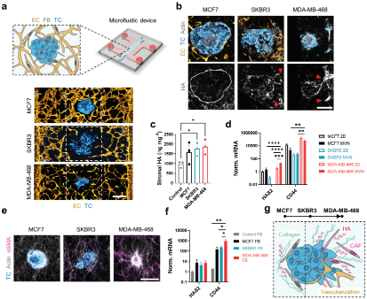- TEL:
- +81-3-5462-4831
- FAX:
- +81-3-5462-4835
※9:00-17:40 Mon.-Fri. (JST)



Giovanni S. Offeddu, Elena Cambria, Sarah E. Shelton, Kristina Haase, Zhengpeng Wan, Luca Possenti, Huu Tuan Nguyen,
Mark R. Gillrie, Dean Hickman, Charles G. Knutson and Roger D. Kamm
Adv Sci (Weinh). 2024 Oct;11(38):e2402757. https://doi.org/10.1002/advs.202402757
Copyright © Authors 2024
This article is licensed under a Creative Commons Attribution 4.0 International License (CC BY).
Desmoplasia in breast cancer is characterized by aberrant extracellular matrix (ECM) and vasculature, leading to impaired drug delivery within the tumor microenvironment. It is a key challenge to identify of personalized therapeutic strategies. While patient-derived tumor models and microphysiological systems are useful for evaluating treatment responses, current models fail to fully replicate the complexity of desmoplasia. Harnessing microphysiological models to discover new therapeutic approaches and improve clinical care for breast cancer patients is essential.
Research AchievementsIn this study, tumoroids formed in PrimeSurfaceTM 96M plates using breast cancer cell lines and patient-derived breast cancer cells were cultured in microphysiological systems including perfusable microvasculature reproduce key aspects of stromal and vascular dysfunction causing impaired drug delivery. Differences were observed in stromal hyaluronic acid (HA) deposition, vascular permeability, and interstitial fluid pressure among cell lines. Interleukin 8 secretion is found responsible for vascular dysfunction and loss of vascular HA. This developed MPS model can be personalized by using patient-derived cells and can be applied to discover new molecular therapies for the normalization of the tumor microenvironment. |

Tumoroids assembled from breast cancer cell lines differentially remodel their surrounding stroma |
Establish MPS model with MVNs incorporating tumoroids:
| Cat # | Product name | Well | Color | Bottom design | Well Vol | Package |
|---|---|---|---|---|---|---|
| MS-9096MZ | PrimeSurface™ 96M | 96 | Transparent | Spindle bottom | 200 μL | Individual packaging 20 plates per case |
Remark